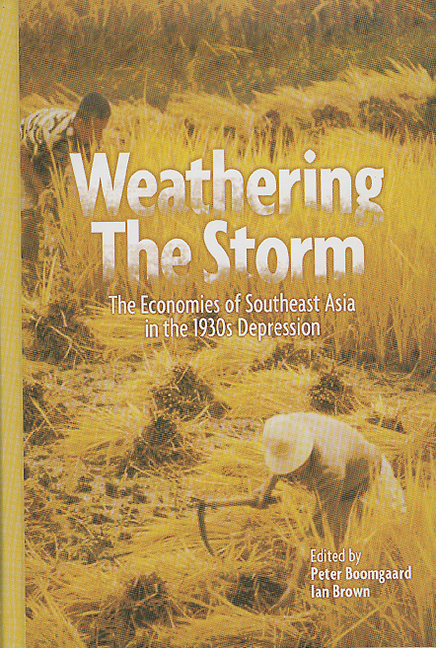Book contents
- Frontmatter
- Contents
- List of Tables
- List of Figures
- Acknowledgements
- List of Contributors
- 1 The Economies of Southeast Asia in the 1930s Depression: An Introduction
- PART I MATERIAL CONDITIONS
- PART II AGRICULTURAL STRATEGIES
- PART III TRADING COMMUNITIES
- PART IV THE STATE'S RESPONSE
- 12 The State and the 1930s Depression in French Indo-China
- 13 Imperial Unity Versus Local Autonomy: British Malaya and the Depression of the 1930s
- 14 Crisis and Response: A Study of Foreign Trade and Exchange Rate Policies in Three Southeast Asian Colonies in the 1930s
- Index
13 - Imperial Unity Versus Local Autonomy: British Malaya and the Depression of the 1930s
from PART IV - THE STATE'S RESPONSE
Published online by Cambridge University Press: 21 October 2015
- Frontmatter
- Contents
- List of Tables
- List of Figures
- Acknowledgements
- List of Contributors
- 1 The Economies of Southeast Asia in the 1930s Depression: An Introduction
- PART I MATERIAL CONDITIONS
- PART II AGRICULTURAL STRATEGIES
- PART III TRADING COMMUNITIES
- PART IV THE STATE'S RESPONSE
- 12 The State and the 1930s Depression in French Indo-China
- 13 Imperial Unity Versus Local Autonomy: British Malaya and the Depression of the 1930s
- 14 Crisis and Response: A Study of Foreign Trade and Exchange Rate Policies in Three Southeast Asian Colonies in the 1930s
- Index
Summary
During the 1930s, British Malaya was caught between two opposing tendencies — an attempt by the British Government to deal with the depression by promoting unity among the Dominions, Colonies, and Protectorates that made up the British Empire; and a move by the local colonial administration to achieve a greater degree of autonomy in economic affairs. The former can be seen in the policy of Imperial Preference introduced following the Ottawa Conference in 1932, while developments in the procurement of labour and food supplies illustrate the latter. On balance, changes introduced during the decade left Malaya more self- sufficient, and less dependent on imperial or regional connections.
‘British Malaya’ refers to the lower part of the Malay Peninsula which, before 1941, included the crown colony of the Straits Settlements as well as four ‘Federated Malay States’ (Perak, Selangor, Negri Sembilan, and Pahang) and five ‘unfederated’ Malay States, all protectorates. The Governor of the Straits Settlements simultaneously served as High Commissioner for the Malay States. Rural Malays had a mixed economy, planting rice along with smallholdings of rubber or fruit trees. They rarely sought employment on mines or estates, which obtained workers from China or India. Mining and plantation industries along the west coast of the peninsula accounted for most of British Malaya's exports, and the greater part of the revenues collected by the colonial administration. In the Straits Settlements, Singapore and Penang functioned as trading entrepôts where merchants imported manufactured goods from industrialized countries for distribution throughout the region, and assembled cargoes of ‘Straits Produce’, a term which embraced a wide variety of primary products grown or collected in Southeast Asia, for shipment to markets outside the region.
The depression caused a fall in prices and a sharp reduction in demand for Malaya's exports. After many years of maintaining a favourable balance of trade, Malaya experienced a small trade deficit in 1928, and much larger deficits in the years 1930 to 1932 (see Table 13.1).
- Type
- Chapter
- Information
- Weathering the StormThe Economies of Southeast Asia in the 1930s Depression, pp. 271 - 294Publisher: ISEAS–Yusof Ishak InstitutePrint publication year: 2001



